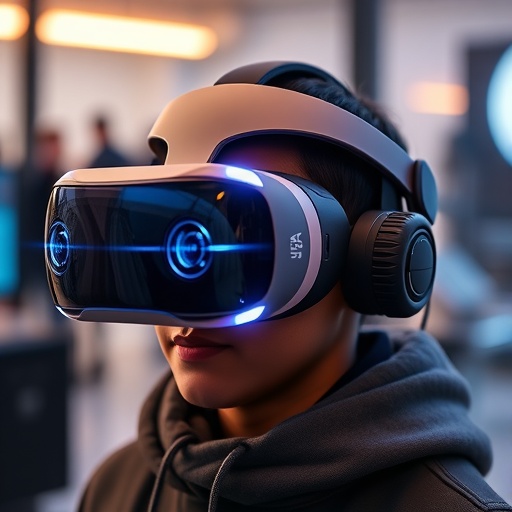Researchers are on the brink of a significant breakthrough in display technology, thanks to novel advancements in light-emitting diode (LED) fabrication. Specifically, a team from Nanjing University led by Tao Tao has demonstrated a revolutionary approach using alternating current (AC) power for powering nano-LED devices, as compared to the conventional direct current (DC) methods. This innovation could drastically simplify the production of nanoscale devices crucial for next-generation virtual and augmented reality headsets, smart glasses, and even various electronic applications ranging from biomedical devices to optical communications.
The traditional LED technology operates on direct current, demanding two points of contact—positive and negative—for power connectivity. This requirement complicates the manufacturing process, especially as device components shrink down to nanoscales. Each microscopic LED component must align perfectly with both contacts, a process rife with challenges. These hurdles pose significant barriers for engineers and manufacturers striving to create ever-smaller and more efficient display technologies.
The research team, through rigorous exploration, realized that utilizing AC power for LED operation could significantly mitigate these complications. By designing a single-contact nano-LED driven purely by AC, they not only reduced the number of connections needed but also allowed engineers to explore a new realm of LED functionality. According to Tao, the shift from DC to AC was not merely an operational change; it was pivotal for advancing LED designs.
The implications of this shift are profound. By simplifying the design process, the researchers were able to implement improvements throughout the fabrication process—enhancing the overall performance of the device. Love for innovation seemed palpable in Tao’s explanation of the project’s motives: they aimed to prove that a single-contact AC-driven nano-LED could function effectively and then go further to analyze its electro-optical behavior along with the mechanisms driving this performance.
A notable part of this research involved the manipulation of AC current frequency to observe its effects at the quantum level—the domain where electrical energy transitions into light. Tao likens this exploration to tuning a dial, adjusting the frequency to best suit different applications. For near-eye displays, it’s crucial to select frequencies that are perceptibly high enough to minimize flicker while also being wary of saturation points that may impede photon production.
The prototype created by the team underscores their commitment to excellence in engineering. By layering semiconductor materials and employing sophisticated etching processes, they crafted an array of nanorods just 300 nanometers thick. This focus on achieving perfectly smooth and uniform structures, devoid of defects or rough edges, is critical. Such precision directly correlates with the quantum efficiency of the device—the translated efficiency of electrical power converted into light—which is essential for high-quality visual outputs.
In an age where augmented reality and virtual reality technologies are more than just concepts, but necessities, the research highlights an urgent need for innovation. Tao points out the distinct advantages that nano-sized components offer over traditional LED sizes, especially in achieving the pixel densities required for next-generation augmented reality glasses. The benefits extend beyond simple aesthetics; their approach promises to yield smaller, more efficient devices, paving the way for richer and more immersive visual experiences.
The academic and applied aspects of this research herald a promising future. The team believes that their findings could lead to innovations that fundamentally change how we perceive and interact with visual media. While the research has been geared toward enhancing near-eye displays, the applications are broad and promising. The advancements they have achieved also hold potential benefits for optical communications, where efficient light generation is crucial, and for biomedical devices that depend on precise light emissions for functionality.
Thus, this groundbreaking research is just the beginning. In the words of Tao, this line of investigation opens doors to realms of technological advancement that could reshape industries. As they venture further into understanding the mechanics of these new AC-driven nano-LED devices, we stand witness to the dawn of better-equipped devices that promise to light our visual experiences both literally and figuratively. Not only does this work exemplify the intersection of innovative design and high-performance functionality, but it also encapsulates the very spirit of scientific discovery—a quest that could lead to options and technologies yet undiscovered, threading the future of technology ever closer to our grasp.
As anticipation builds within the scientific community and tech industries alike, this research potentially signifies a leap beyond the limitations of existing LED technologies. With the knowledge gained and the methodologies established, researchers hope to share their findings widely and inspire further advancements. The collaboration of brilliant minds has produced results that could soon migrate from the pages of research journals into real-world applications that change lives.
Subject of Research: Investigation on the fabrication and physical mechanisms of single-contact AC-driven nano-LED devices
Article Title: Investigation on fabrication and physical mechanisms of single-contact AC-driven nano-LED devices
News Publication Date: 4-Nov-2025
Web References: https://doi.org/10.1063/5.0292605
References: AIP Publishing, Applied Physics Letters
Image Credits: Tao Tao
Keywords
Light Emitting Diodes, Nano-LEDs, Alternating Current, Quantum Efficiency, Near-Eye Displays, Biomedical Devices, Optical Communications.




